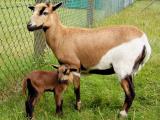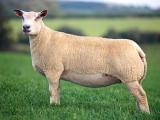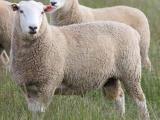
|
California Red SheepThe California Red was developed in 1970. It is a cross between Barbados and Tunis sheep. Considered medium-sized sheep, mature rams weigh 225 to 250 pounds and ewes range from 130 to 150 pounds. Both sexes are naturally hornless. Lambs are born a solid rust or cinnamon red color, a color that is retained as they mature. |

|
California Variegated Mutant SheepThe Romeldale is a breed of sheep developed by A.T. Spencer, who felt the Romney breed would increase the staple, length, and carcass quality of his Rambouillets. Through many years of selection, the Romeldale breed was developed, with fleece properties of 60-64's, extremely high yield, and uniformity including carcass cutability superior to the other whiteface breeds. During the 1960's, Glen Eidman, a partner of J.K. Sexton, found in his purebred Romeldale flock a multi-colored ewe lamb. |

|
Cambridge SheepThe Cambridge is a dark faced, medium sized sheep with an average quality white fleece. It was founded in 1964 at Cambridge University. The female foundation stock consisted of very prolific ewes selected within native breeds. Most ewes were from the Clun Forest breed, but the Lleyn, Llanwenog and Kerry Hill breeds also contributed signficantly, and the Radnor, Ryeland, Border Leicester, and Suffolk to a lesser extent. |

|
Cameroon SheepThe Cameroon sheep is a hair sheep from West Africa. Instead of wool, they carry a hair coat that in the autumn forms an additional undercoat, which is shed after winter. Cameroon sheep do not require shearing. |

|
Castlemilk Morrit SheepDuring the early years of the 20th century, the late Sir Jock Buchanan-Jardine began a breeding program on his Castlemilk Estate in Dumfriesshire. Using Manx Loghtan, moorit Shetland, and wild Mouflon, he developed a breed to beautify his parkland and provide fine, kemp-free moorit colored wool. On the death of Sir John Buchanan-Jardine the flock was dispersed in 1970, and six ewes and a ram were bought by Joe Henson at the Cotswold Farm Park. |

|
Charmoise Hill SheepThe Charmoise sheep originated in the hills of France and has been used in the production of continental terminal breeds such as the Charollais and the Rouge. The Charmoise is a genuine hill breed, the first to be imported to Britain from the Continent. The breed was formed in France in the late 18th century by the introduction of Kent rams from England, which were crossed on the indiginous hill and mountain breeds to give them a better shape. |

|
Charollais SheepCharollais sheep are from the same region of France as Charolais cattle. They originated in the early 1800's from a cross of the British Dishley Leicester with local landrace breeds. The Charollais breed is a medium sized, heavy sheep, with a long loin and well muscled hindquarters. Their clean head is pinkish grey. Their wool is fine to medium and dense. |

|
Chios SheepLike many breeds, the exact origin of the Chios is unknown. Some sources suggest it is the result of crossbreeding between local sheep of the island of Chios (Greece) and breeds from Anatolia (Turkey). The Chios is typically white with black, occasionally brown, spots around the eyes, and on the ears, nose, belly and legs. The entire head is often black. |

|
Churra SheepThe Churra sheep is an native breed raised in Castile and León in northwestern Spain. It is a milk production breed of great hardiness, well suited to the continental climate of Castile and León, with long, severe winters, very short springs, and hot dry summers. |

|
Clun Forest SheepThe Clun Forest originated in the mountainous district of South West Shropshire in England, adjoining the Welsh Border, and are the most numerous sheep of the Marshes of Wales. They take their name from the ancient market town of Clun. Some authors attribute the breed to a combination of Hill Radnor and Shropshire, with Kerry Hill breeding also introduced in about 1865. |

|
Coburg SheepIn the 19th century this landrace sheep populated the European hilly ranges abundantly. These red fox-colored sheep could be found under names that indicated their color or living area, such as Golden Fox, Eisfelder Fox Sheep, Eifeler Sheep, Ardenais Solognotes, or Rousse Tetes. In the beginning of the 20th century, 60% of the sheep in the German Coburg area were of this landrace with the red fox-colored heads, but by World War II they were nearly extinct. |

|
Columbia SheepThe Columbia is truly an All-American breed, the first to originate in the United States. Columbias were developed in 1912 from Lincoln and Rambouillet crosses. The object of the cross was to create a breed that produced more pounds of wool and lamb and could replace crossbreeding on the range. |

|
Comisana SheepThe Comisana is one of the most important breeds of Mediterranean sheep. The breed is valued for its high milk yield, processed on site to produce a variety of home-made high quality cheeses, following a tradition lasting thousands of years. The average production of Comisana ewes is 200 liters per lactation. |

|
Coopworth SheepThe Coopworth is a medium sized, dual-purpose, white faced sheep with an alert but quiet disposition. It is one of the most dominant breeds in New Zealand. It originated in New Zealand in the 1960's from Border Leicester and Romney crosses, and was first imported into the United States during the late 1970's. |

|
Cormo SheepCormo is a system of breeding in which selection is based on scientific measurement of commercially desirable characteristics. Selection criteria include clean fleece weight, fiber diameter, growth or body weight, and fertility. Originating in Tasmania, Australia, the Cormo derives its name from its two parent breeds: Corriedale and Superfine Saxon Merino. |

|
Corriedale SheepThe Corriedale is the oldest of all the crossbred wool breeds, a Merino-Lincoln cross developed in Australia and New Zealand and first brought to the United States in 1914. Corriedales are a dual-purpose sheep with good meat and wool. |

|
Cotswold SheepThe Cotswold is an ancient breed of sheep descended from sheep that grazed the Cotswold Hills at the time of Caesar's conquest of Britain. In the Middle Ages, Cotswold wool was a major export of England, contributing greatly to the wealth of the country as a whole and particularly to the Cotswold region, where the wool churches and large houses remain as evidence of its importance at that time. |
| Https://phonetech.ee https://phonetech.ee саи samsung remont. phonetech.ee |